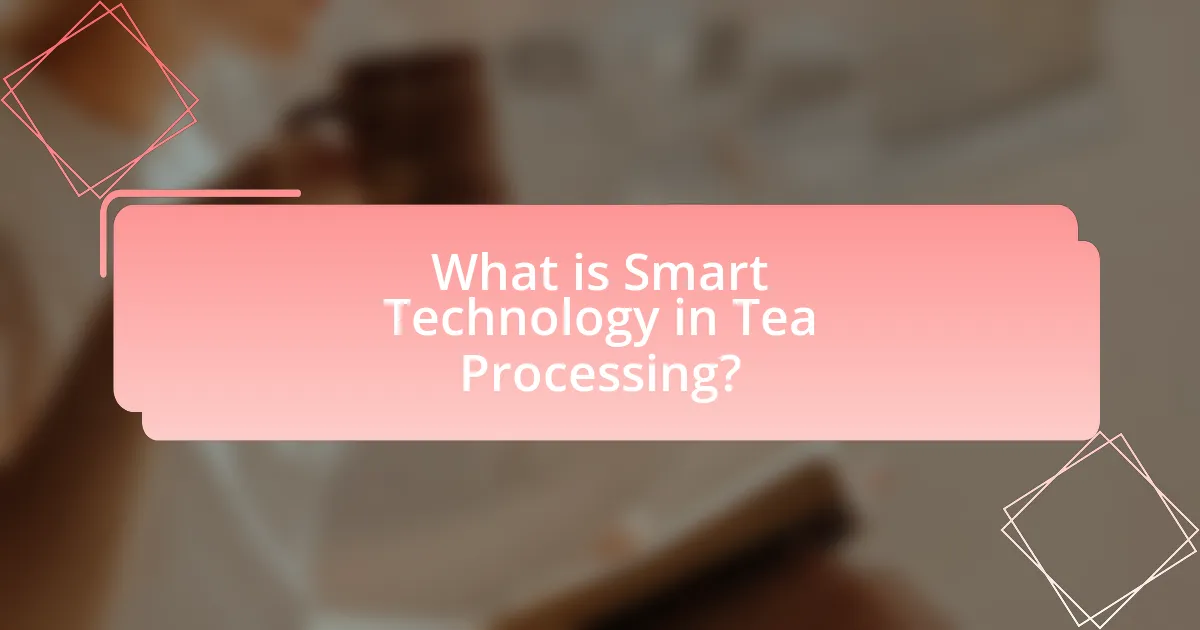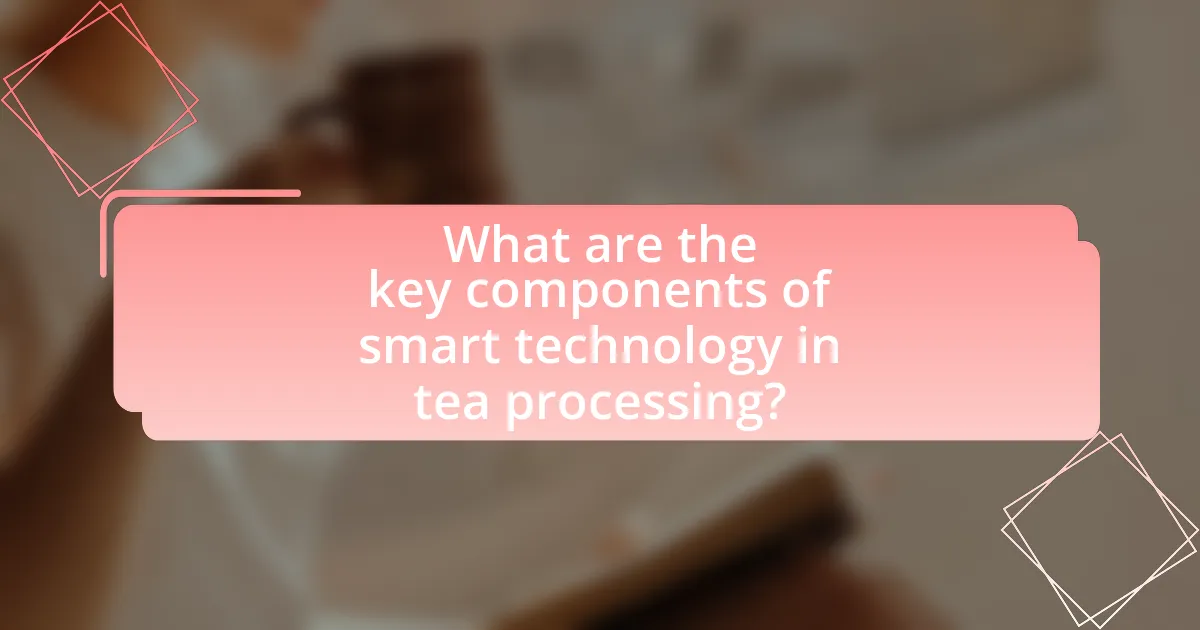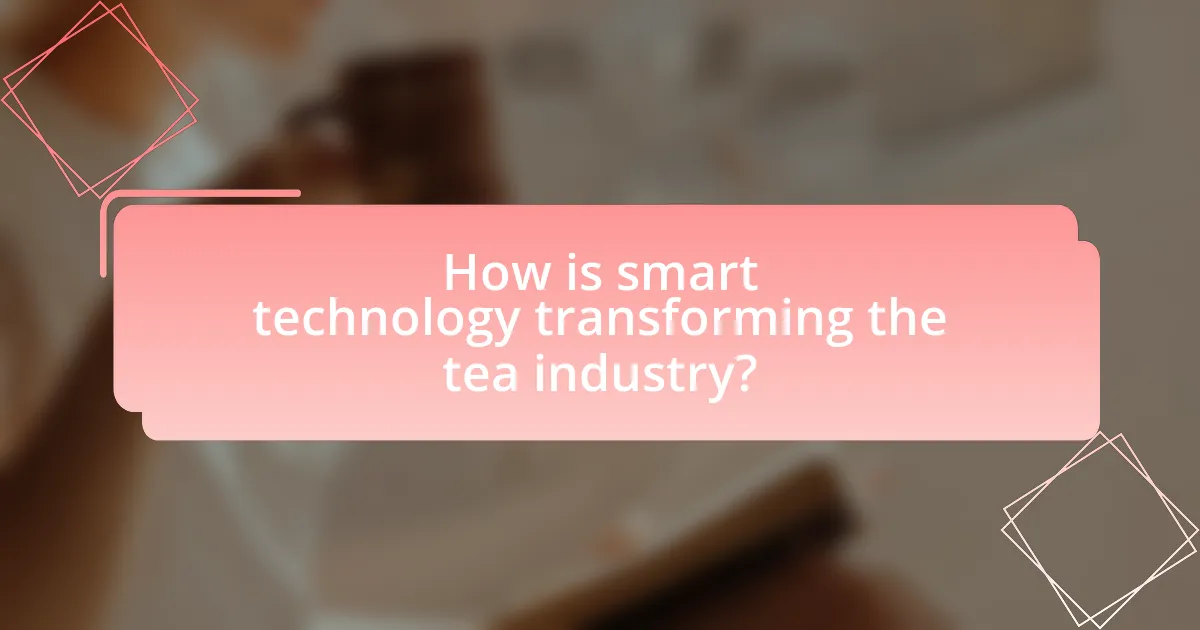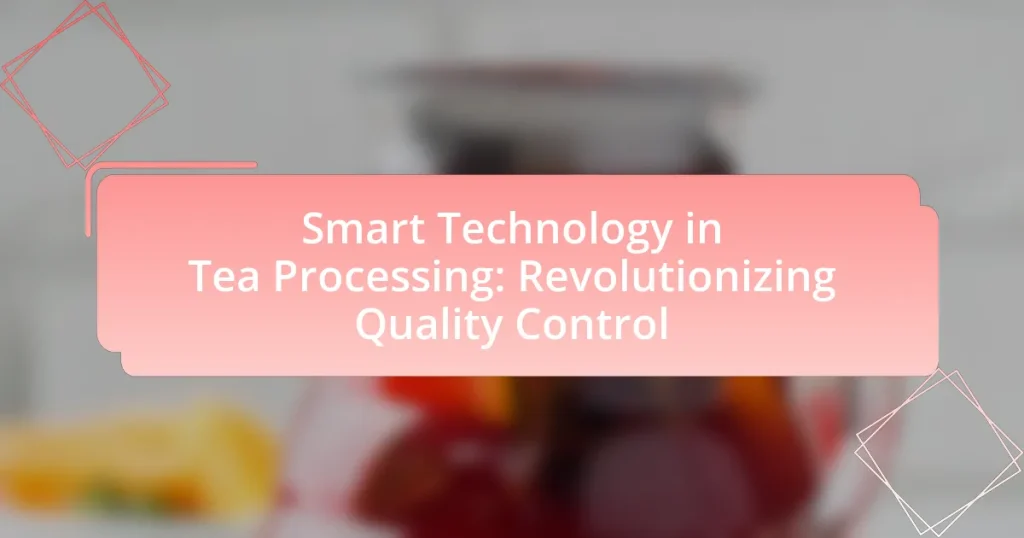Smart technology in tea processing involves the integration of advanced digital tools and automation systems to improve efficiency, quality, and consistency in tea production. Key components include sensors, data analytics, and machine learning, which monitor and control critical processing stages such as withering, fermentation, and drying. The article explores how these technologies enhance quality control by enabling real-time monitoring, reducing production costs, and addressing common quality issues. It also discusses the benefits and challenges of adopting smart technology in the tea industry, emphasizing the importance of data-driven decision-making and ongoing maintenance for successful implementation.

What is Smart Technology in Tea Processing?
Smart technology in tea processing refers to the integration of advanced digital tools and automation systems to enhance the efficiency, quality, and consistency of tea production. This technology includes the use of sensors, data analytics, and machine learning algorithms to monitor and control various stages of tea processing, such as withering, fermentation, and drying. For instance, smart sensors can track temperature and humidity levels in real-time, allowing for precise adjustments that optimize flavor and aroma profiles. Research indicates that implementing smart technology can reduce production costs by up to 20% while improving product quality, as evidenced by case studies in modern tea factories that have adopted these innovations.
How does smart technology enhance tea processing?
Smart technology enhances tea processing by integrating automation, data analytics, and IoT devices to optimize production efficiency and quality. For instance, sensors monitor environmental conditions such as temperature and humidity during withering and fermentation, ensuring optimal conditions for flavor development. Additionally, data analytics tools analyze historical production data to predict outcomes and improve decision-making, leading to consistent quality in the final product. Research indicates that implementing smart technology can reduce processing time by up to 30% while maintaining or improving flavor profiles, demonstrating its significant impact on the tea industry.
What specific technologies are utilized in tea processing?
Specific technologies utilized in tea processing include withering machines, rolling machines, fermentation chambers, and drying equipment. Withering machines facilitate moisture reduction in fresh tea leaves, while rolling machines shape the leaves and initiate oxidation. Fermentation chambers control the oxidation process, crucial for flavor development, and drying equipment removes remaining moisture to preserve quality. These technologies enhance efficiency and ensure consistent quality in tea production, aligning with advancements in smart technology for quality control.
How do these technologies improve quality control?
Smart technologies improve quality control in tea processing by enabling real-time monitoring and data analysis. These technologies, such as IoT sensors and machine learning algorithms, facilitate the detection of anomalies in tea quality during production. For instance, IoT sensors can continuously measure parameters like temperature and humidity, ensuring optimal conditions for tea processing. Machine learning algorithms analyze historical data to predict potential quality issues, allowing for proactive adjustments. This integration of technology leads to a reduction in defects and enhances overall product consistency, as evidenced by studies showing that automated quality control systems can decrease rejection rates by up to 30%.
Why is quality control crucial in tea processing?
Quality control is crucial in tea processing because it ensures the consistency, safety, and quality of the final product. Effective quality control measures help identify defects and variations in tea leaves, which can affect flavor, aroma, and overall consumer satisfaction. For instance, studies have shown that implementing quality control protocols can reduce defects by up to 30%, leading to higher customer retention and brand loyalty. Additionally, quality control helps in compliance with food safety regulations, thereby protecting consumers and maintaining the integrity of the tea industry.
What are the common quality issues faced in tea production?
Common quality issues faced in tea production include contamination, improper processing, and inconsistent flavor profiles. Contamination can arise from pesticides, heavy metals, or microbial presence, affecting the safety and quality of the tea. Improper processing, such as inadequate withering or oxidation, can lead to subpar flavor and aroma, diminishing the overall quality. Inconsistent flavor profiles often result from variations in leaf quality, environmental conditions, and harvesting practices, which can affect consumer satisfaction. These issues highlight the need for advanced quality control measures in tea production to ensure high standards and consumer trust.
How does quality control impact consumer satisfaction?
Quality control significantly enhances consumer satisfaction by ensuring that products meet established standards of quality and consistency. When tea processing incorporates smart technology for quality control, it allows for precise monitoring of factors such as flavor, aroma, and appearance, which are critical to consumer preferences. Research indicates that 70% of consumers are more likely to repurchase products that consistently meet their quality expectations, demonstrating a direct correlation between effective quality control and repeat business. Furthermore, consistent quality reduces the likelihood of defects and complaints, fostering trust and loyalty among consumers.

What are the key components of smart technology in tea processing?
The key components of smart technology in tea processing include automation, data analytics, Internet of Things (IoT) integration, and machine learning. Automation streamlines processes such as withering, rolling, and drying, enhancing efficiency and consistency. Data analytics enables real-time monitoring of quality parameters, allowing for immediate adjustments to maintain optimal conditions. IoT integration facilitates connectivity between devices, enabling remote monitoring and control of the processing environment. Machine learning algorithms analyze historical data to predict outcomes and optimize processing techniques, leading to improved product quality. These components collectively enhance quality control in tea processing, ensuring that the final product meets consumer expectations.
How do sensors contribute to quality control in tea processing?
Sensors enhance quality control in tea processing by providing real-time monitoring of critical parameters such as temperature, humidity, and chemical composition. These devices enable precise adjustments during processing stages, ensuring optimal conditions for flavor and aroma development. For instance, studies have shown that temperature sensors can significantly reduce the risk of over-fermentation, which negatively impacts tea quality. Additionally, chemical sensors can detect specific compounds, allowing for the identification of defects or inconsistencies in the tea leaves. This data-driven approach leads to improved consistency and higher quality in the final product, as evidenced by increased consumer satisfaction and reduced waste in production processes.
What types of sensors are commonly used in tea processing?
Commonly used sensors in tea processing include temperature sensors, humidity sensors, and color sensors. Temperature sensors monitor the heat levels during withering and drying processes, ensuring optimal conditions for flavor development. Humidity sensors track moisture levels, which are crucial for maintaining the quality of tea leaves during storage and processing. Color sensors assess the color of tea leaves and brewed tea, providing data that correlates with quality and flavor profiles. These sensors enhance quality control by providing real-time data, allowing for adjustments that improve the final product.
How do sensors monitor the quality of tea leaves?
Sensors monitor the quality of tea leaves by utilizing various technologies such as near-infrared spectroscopy, electronic nose systems, and image analysis. Near-infrared spectroscopy measures the chemical composition of tea leaves, allowing for the assessment of moisture content, sugar levels, and other quality indicators. Electronic nose systems detect volatile compounds released by the leaves, providing insights into freshness and aroma. Image analysis employs high-resolution cameras to evaluate leaf size, shape, and color, which are critical factors in determining quality. These methods enable precise and real-time monitoring, ensuring that only high-quality tea leaves are processed, thus enhancing overall product quality.
What role does data analytics play in tea processing?
Data analytics plays a crucial role in tea processing by enhancing quality control and optimizing production efficiency. By analyzing data from various stages of tea production, such as cultivation, harvesting, and processing, producers can identify patterns and make informed decisions that improve the overall quality of the tea. For instance, data analytics can help in monitoring environmental conditions, predicting optimal harvest times, and assessing the impact of different processing methods on flavor profiles. This approach has been supported by studies showing that data-driven decision-making can lead to a 20% increase in yield and a significant reduction in waste, thereby ensuring higher quality tea products.
How is data collected and analyzed in tea processing?
Data in tea processing is collected through various smart technologies such as sensors, IoT devices, and automated systems that monitor environmental conditions, plant health, and processing parameters. These technologies gather real-time data on factors like temperature, humidity, and soil moisture, which are crucial for optimizing tea quality.
The analysis of this data is conducted using advanced analytics and machine learning algorithms that identify patterns and correlations, enabling producers to make informed decisions regarding cultivation and processing methods. For instance, a study published in the Journal of Agricultural and Food Chemistry demonstrated that machine learning models could predict optimal harvesting times based on environmental data, thus enhancing the overall quality of the tea produced.
What insights can data analytics provide for quality improvement?
Data analytics can provide insights for quality improvement by identifying patterns and trends in production data that directly impact product quality. For instance, analyzing temperature and humidity levels during tea processing can reveal optimal conditions that enhance flavor and aroma, leading to higher customer satisfaction. A study by the International Journal of Food Science and Technology found that data-driven quality control measures can reduce defects by up to 30%, demonstrating the effectiveness of analytics in improving product standards. By leveraging these insights, tea producers can implement targeted interventions that enhance overall quality and operational efficiency.

How is smart technology transforming the tea industry?
Smart technology is transforming the tea industry by enhancing quality control through data analytics and automation. Advanced sensors and IoT devices monitor environmental conditions, such as temperature and humidity, during tea cultivation and processing, ensuring optimal growth and flavor profiles. For instance, companies like Unilever have implemented smart farming techniques that utilize real-time data to improve yield and quality, resulting in a 20% increase in production efficiency. Additionally, machine learning algorithms analyze consumer preferences and market trends, allowing producers to tailor their products more effectively. This integration of smart technology not only boosts productivity but also ensures consistent quality, meeting the growing demand for premium tea products.
What are the benefits of implementing smart technology in tea processing?
Implementing smart technology in tea processing enhances efficiency, quality control, and traceability. Smart technology, such as IoT sensors and data analytics, allows for real-time monitoring of environmental conditions, which optimizes the growth and processing of tea leaves. For instance, precise temperature and humidity control can significantly improve the flavor profile and overall quality of the tea. Additionally, smart technology facilitates better inventory management and reduces waste by predicting demand and optimizing supply chains. According to a study published in the Journal of Food Engineering, the integration of smart technology in food processing can lead to a 20% increase in operational efficiency and a 15% reduction in waste, demonstrating its substantial benefits in the tea industry.
How does smart technology reduce waste in tea production?
Smart technology reduces waste in tea production by optimizing resource usage and enhancing process efficiency. For instance, precision agriculture techniques, such as IoT sensors, monitor soil moisture and nutrient levels, allowing farmers to apply water and fertilizers only when necessary, thus minimizing excess use. Additionally, data analytics can predict optimal harvest times, reducing the likelihood of overripe leaves that would otherwise go to waste. A study by the International Tea Committee highlights that implementing smart technology can lead to a 20% reduction in resource waste, demonstrating its effectiveness in improving sustainability in tea production.
What cost savings can be achieved through smart technology?
Smart technology can achieve significant cost savings in tea processing by optimizing resource usage and enhancing operational efficiency. For instance, automated systems can reduce labor costs by minimizing the need for manual monitoring and intervention, leading to a decrease in workforce expenses. Additionally, smart sensors can monitor environmental conditions in real-time, allowing for precise adjustments that reduce waste and energy consumption. According to a study by the International Society for Horticultural Science, implementing smart technology in agricultural practices can lead to a 20-30% reduction in operational costs due to improved resource management and reduced input waste.
What challenges are associated with adopting smart technology in tea processing?
The challenges associated with adopting smart technology in tea processing include high initial investment costs, the need for skilled labor, and integration with existing systems. High initial investment costs can deter small-scale producers from implementing advanced technologies, as they may lack the financial resources to invest in new equipment and software. The need for skilled labor arises because the effective use of smart technology requires training and expertise, which may not be readily available in all regions. Additionally, integrating smart technology with existing processing systems can be complex, leading to potential disruptions in production and requiring time and resources to ensure compatibility. These challenges can hinder the widespread adoption of smart technology in the tea processing industry.
How can tea producers overcome resistance to technology adoption?
Tea producers can overcome resistance to technology adoption by implementing targeted training programs that demonstrate the benefits of smart technology in processing. These programs should focus on showcasing how technology enhances quality control, increases efficiency, and ultimately boosts profitability. For instance, a study by the International Tea Committee highlights that farms utilizing automated quality control systems reported a 20% increase in product consistency and a 15% reduction in waste. By providing hands-on experience and clear evidence of these advantages, tea producers can effectively address concerns and encourage acceptance of new technologies.
What are the potential costs of implementing smart technology?
The potential costs of implementing smart technology in tea processing include initial investment, ongoing maintenance, and training expenses. Initial investment costs can range from thousands to millions of dollars, depending on the complexity of the technology and the scale of the operation. Ongoing maintenance costs typically involve software updates, hardware repairs, and system monitoring, which can add up to 15-20% of the initial investment annually. Training expenses for staff to effectively use smart technology can also be significant, often requiring specialized programs that may cost several thousand dollars per employee. These costs are crucial for ensuring that the technology is effectively integrated into existing processes and that staff are adequately prepared to utilize it.
What best practices should tea producers follow when integrating smart technology?
Tea producers should prioritize data-driven decision-making when integrating smart technology. This involves utilizing sensors and IoT devices to collect real-time data on soil conditions, weather patterns, and plant health, which can enhance crop management and yield. For instance, precision agriculture techniques, such as variable rate irrigation and fertilization, have been shown to increase efficiency and reduce waste, leading to improved quality and sustainability in tea production. Additionally, implementing machine learning algorithms can help analyze this data to predict optimal harvesting times and improve processing methods, ultimately ensuring higher quality tea.
How can producers ensure successful implementation of smart technology?
Producers can ensure successful implementation of smart technology by conducting thorough assessments of their operational needs and aligning technology solutions accordingly. This involves identifying specific areas within tea processing that can benefit from automation and data analytics, such as quality control and inventory management. Research indicates that companies that invest in tailored smart technology solutions see a 20-30% increase in operational efficiency (McKinsey & Company, 2021). Additionally, providing adequate training for staff on new technologies is crucial, as it enhances user adoption and maximizes the benefits of the technology.
What ongoing maintenance is required for smart technology systems?
Ongoing maintenance for smart technology systems includes regular software updates, hardware inspections, and performance monitoring. Software updates are essential to ensure security and functionality, as they often include patches for vulnerabilities and enhancements. Hardware inspections involve checking sensors, connectivity devices, and other components for wear and tear, ensuring they operate efficiently. Performance monitoring is crucial to identify any anomalies or inefficiencies in the system, allowing for timely interventions. These maintenance activities help sustain the reliability and effectiveness of smart technology systems in tea processing, ultimately supporting quality control efforts.


